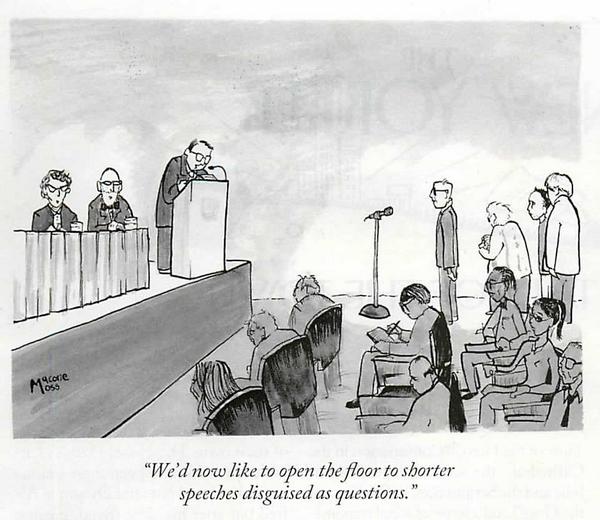At the end of each and every presentation at a conference, there is the obligatory question from the chairperson to the audience “Are there any questions?” There are many reasons why Q&As are not such a good idea.
Why is it that so frequently in conferences when it comes to the Q&A people grandstand – in other words, rather than ask a question, they give a speech?
I think that often it is because it is the only opportunity they get to talk rather than be “talked at.” The need to express their opinion builds up inside them over time until it eventually bursts out.
One way of helping to reduce this tendency is to allow the audience to talk with the people close to them by making the conference a conversational one.
But there are other severe issues with Q&A sessions described by Nancy Dixon and Johnnie Moore in the resources section below.
Four kinds of people who ruin academic conferences | Joshua Vossler

Conference Q&A sessions are not interaction but simply eliminating them is not the answer. We need to create ways to engage the audience and allow them to become participants.
Tweet This
- We have time for just one long-winded, self-indulgent question that relates to nothing we have been talking about.
- We’d now like to open the floor to shorter speeches disguised as questions.
Things Todo
- Next time you give a presentation at a conference – make it a conversational talk.
Resources
- Blog Post: Q and A is not “interaction” by Johnnie Moore
- Blog Post: A Rant on “Are There Any Questions?” by Nancy Dixon
- Blog Post: Don’t ask, “are there any questions?” by Jesús Gil Hernández
POST NAVIGATION
CHAPTER NAVIGATION
SEARCH
Blook SearchGoogle Web Search
Photo Credits: Naseej Academy ()
The Gurteen Knowledge Letter is a free monthly newsletter with over 20,000 subscribers that I have been publishing by email for over 20 years.
Learn more about the newsletter and register here.


